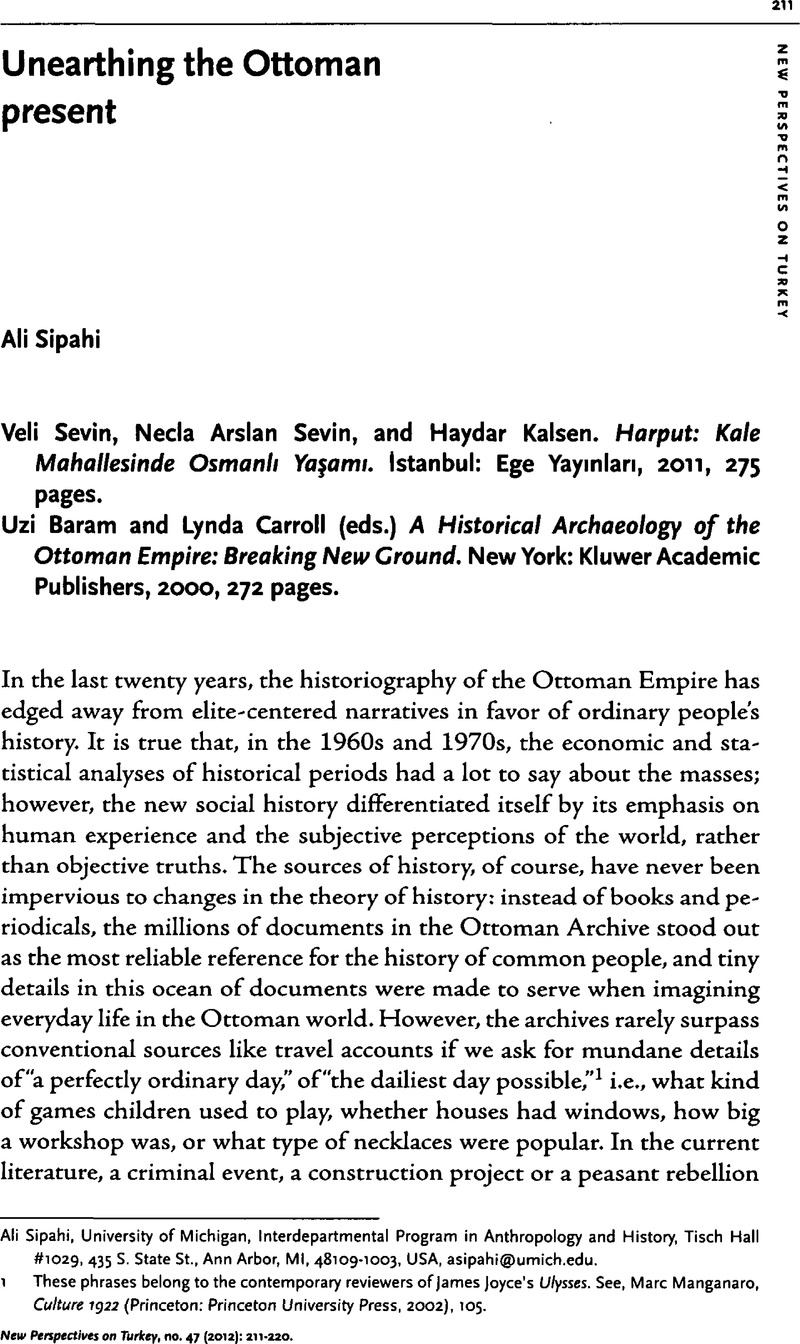No CrossRef data available.
Article contents
Unearthing the Ottoman present
Published online by Cambridge University Press: 05 March 2015
Abstract
An abstract is not available for this content so a preview has been provided. Please use the Get access link above for information on how to access this content.

- Type
- Review Articles
- Information
- New Perspectives on Turkey , Volume 47: Special Issue on Turkey's Experience with Neoliberal Policies and Globalization , Fall 2012 , pp. 211 - 220
- Copyright
- Copyright © New Perspectives on Turkey 2012
References
Appadurai, Arjun, ed. The Social Life of Things: Commodities in Cultural Perspective. Cambridge: Cambridge University Press, 1988.Google Scholar
Bahrani, Zainab, Çelik, Zeynep, and Eldem, Edhem, eds. Scramble for the Past: A Story of Archaeology in the Ottoman Empire 1753-1914. İstanbul: Salt, 2011.Google Scholar
Baram, Uzi. “Above and Beyond Ancient Mounds: The Archaeology of the Modern Periods in the Middle East and Eastern Mediterranean.” In International Handbook of Historical Archaeology, edited by Majewski, Teresita and Gaimster, David R.M., 647–661. New York: Springer, 2009.CrossRefGoogle Scholar
Buchli, Victor, and Lucas, Gavin, eds. Archaeologies of the Contemporary Past. London: Routledge, 2001.Google Scholar
Chidester, Robert C. “Class, Community, and Materiality in a Blue-Collar Baltimore Neighborhood: An Archaeology of Hampden-Woodberry.” Unpublished PhD Dissertation, University of Michigan, 2009.Google Scholar
Croucher, Sarah K., and Weiss, Lindsay, eds. The Archaeology of Capitalism in Colonial Contexts Postcolonial Historical Archaeologies. New York: Springer, 2011.CrossRefGoogle Scholar
Dawdy, Shannon Lee. “Clockpunk Anthropology and the Ruins of Modernity.” Current Anthropology 51, no. 6 (2010): 761–793.CrossRefGoogle Scholar
Dawdy, Shannon Lee. “Millennial Archaeology: Locating the Discipline in the Age of Insecurity.” Archaeological Dialogues 16, no. 2 (2009): 131–142.CrossRefGoogle Scholar
Dawdy, Shannon Lee. “Thinker-tinkers, Race and the Archaeological Critique of Modernity.” Archaeological Dialogues 12, no. 2 (2006): 143–164.CrossRefGoogle Scholar
Gould, Richard A., and Schiffer, Michael B.Modern Material Culture: The Archaeology of Us. London: Academic Press, 1981.Google Scholar
Haglund, William D., Connor, Melissa, and Scott, Douglas D. “The Archaeology of Contemporary Mass Craves.” Historical Archaeology 35, no. 1 (2001): 57–69.CrossRefGoogle Scholar
Harrison, Rodney. “Surface Assemblages: Towards an Archaeology in and of the Present.” Archaeological Dialogues 18, no. 2 (2011): 141–161.CrossRefGoogle Scholar
Insan Haklan Derneği Diyarbakır Şubesi. “Toplu Mezar Haritası.” http://www.ihddiyarbakir.org/Map.aspx.Google Scholar
Insan Haklan Derneği Diyarbakır Şubesi. Türkiye’de Toplu Mezarlar Raporu. Diyarbakır: İnsan Hakları Derneği Diyarbakır Şubesi, 2011, http://www.ihddiyarbakir.org/UserFiles/261749İHD-TOPLU MEZAR RAPORU.pdf.Google Scholar
Juhl, Kirşten. The Contribution by (Forensic) Archaeologists to Human Rights Investigations of Mass Craves. Stavanger: Arkeologisk museum i Stavanger, 2005.Google Scholar
Orser, Charles E. “Twenty-First-Century Historical Archaeology.” Journal of Archaeological Research 18, no. 2 (2010): 111–150.CrossRefGoogle Scholar
Orser, Charles E. “World-Systems Theory, Networks, and Modern-World Archaeology.” In International Handbook of Historical Archaeology, edited by Majewski, Teresita and Gaimster, David R.M., 253–268. New York: Springer, 2009.CrossRefGoogle Scholar
Palmer, Marilyn, and Neaverson, Peter. Industrial Archaeology: Principles and Practice. New York: Routledge, 1998.Google Scholar
Rathje, William. “Integrated Archaeology: A Garbage Paradigm.” In Archaeologies of the Contemporary Past, edited by Buchli, Victor and Lucas, Gavin, 63–75. London: Routledge, 2001.Google Scholar
Ruin Memories: Materiality, aesthetics and the archaeology of the recent past, http://ruinmemories.org.Google Scholar
Sevin, Veli, Sevin, Necla Arslan, and Kalsen, Haydar. Harput Kale Mahallesinde Osmanlı Yaşamı. İstanbul: Ege Yayınları, 2011.Google Scholar
Stahlgren, Lori C. “Negotiating History, Slavery, and the Present: Archaeology at Farmington Plantation.” In Archaeologists as Activists: Can Archaeologists Change the World?, edited by Stottman, M. Jay, 95–109. Alabama: University of Alabama Press, 2010.Google Scholar
Veinstein, Gilles. “On the Çiftlik Debate.” In Landholding and Commercial Agriculture in the Middle East, edited by Keyder, Çağlar and Tabak, Faruk, 35–56. New York: State University of New York Press, 1991.Google Scholar
Wolf, Eric R.Europe and the People without History. Berkeley: University of California Press, 1982.Google Scholar
Wright, R., Hanson, I., and Sterenberg, J. “The Archaeology of Mass Graves.” In Forensic Archaeology: Advances in Theory and Practice, edited by Hunter, John and Cox, Margaret, 137–157. London: Routledge, 2005.Google Scholar
Zimmerman, Larry J., Singleton, Courtney, and Welch, Jessica. “Activism and Creating a Translational Archaeology of Homelessness.” World Archaeology 42, no. 3 (2010):443–454.CrossRefGoogle Scholar




